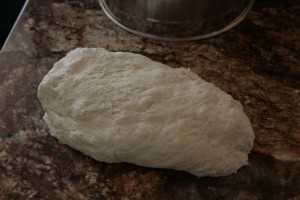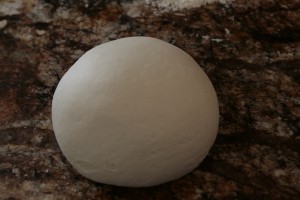Recipe: Neapolitan Pizza Dough
Note from Peter: I’ve been receiving a lot of requests for a proper VPN Napoletana dough. I’ve posted this previously on the Forno Bravo site, but wanted to be sure I also made it available here on PizzaQuest — especially in light of Brad’s recent post on making Margherita pizzas in two different ovens. Enjoy!!
A true Naples dough uses only flour, water, salt, and yeast. Some versions substitute sourdough starter for the yeast and some use a combination of both commercial yeast and natural starter. But this version is for yeast only (I recommend instant yeast). Also, it is customarily made with Italian -00- flour, of which there are a few brands available. Caputo is the most well known brand but now there are also American brands, such as King Arthur and Central Milling, who make their own version of this flour. Double Zero (-00-) means that it has been sifted fully to leave behind only the pure endosperm of the wheat, and typically uses a somewhat softer wheat than what we know as bread flour — more like all purpose flour, mixed with a little pastry flour, so that the gluten content is closer to 9.5% to 10%. But even this may vary because -00- doesn’t really refer to gluten, just to the purity of the grind and sifting. For this reason, any recipe can only give an approximation of the water content, depending on which brand of flour you use. You will have to adjust when you make it based on the feel of the dough. It shouldn’t be sticky, but it should be very supple and also tacky to the touch. The following recipe is based on the one from American Pie: My Search for the Perfect Pizza (Ten Speed Press, 2003). It will make five 8-ounce doughs (227 g), or six 6-ounce doughs (170 g).
5 cups unbleached all purpose or -00- flour (22.5 oz / 638 g)
1 3/4 teaspoons table salt (0.43 oz / 12.5 g) (if using coarse kosher salt it will be closer to 2 teaspoons)
1 teaspoon instant yeast (0.11 oz / 3 g)
1 3/4 cups plus 2 tablespoons cool water, 65º F (15 oz / 425 g)
- Mix all the ingredients together in a large bowl or an electric mixer on slow speed (use the paddle attachment) for about 1 minute. Let the dough rest for 5 minutes. If using a mixer, switch to the dough hook, then continue mixing on second speed for about 2 to 4 minutes, or until the dough is smooth and supple. Add flour or water if needed.
- Transfer the dough to a slightly oiled work surface and hand knead for an additional minute, making any final adjustments. The dough should be tacky but not sticky and feel very supple, not stiff. Cover the dough with a bowl and let it rest for 30 minutes.
- Divide the dough into desired size pieces and form each piece into a ball. Place the dough balls onto a lightly oiled pan or into a dough box. Mist with pan spray and cover with plastic wrap, a large plastic bag or trash can liner, or a lid. Place the pan into a refrigerator to slowly ferment overnight. (Note: if making pizza on the same day, allow at least 6 to 8 hours in the fridge). They will keep in the refrigerator for up to three days. (You can also refrigerate the whole dough, in a covered bowl or container, and divide and ball it the next day, two hours before you plan to make the pizzas).
- Remove the dough balls from the refrigerator 2 hours before you plan to bake the pizza to take off the chill and make them easier to stretch. (Note: You can also freeze the dough balls by placing them each in their own freezer zip bag that has been misted with spray oil. They will keep for up to three months. Move them to the refrigerator the day before you plan to make the pizzas to slowly thaw, then treat them as refrigerated dough the next day).
After that it’s all about the pizzas. Crank your home oven up as hot as it will go, preheat the baking stone for at least 45-60 minutes, and make your favorite version of Margherita or any Napoletana pizza.
We’d love to get your comments on this (below) as well as any photos you’d like to share. Send the photos to us at info@pizzaquest.com and we’ll add them to our media library and post the best ones.
May your pizzas all be perfect!!!
Peter
Recent Articles by Peter Reinhart
- Pizza Quest: Chef Mike Friedman’s Pizza and Other Jewish Italian American Tributes in DC
- Pizza Quest: Animal-Free Cheese that Actually Tastes and Melts Like Cheese
- Pizza Quest, with Guests Jillana Miller and Ahmad Butler, aka Miller-Butler
- Pizza Quest: Shannon Mangini — Things Can Happen Fast
- Pizza Quest: Anthony Mangieri, with Big News About His New Line of Frozen Pizzas
- Pizza Quest: Author Ron Costello on The Hill (Where Both He and Peter Grew Up)
Add Comment
You must be logged in to post a comment.














I went through the rigorous training at the AVPN school in naples last year and this is nothing like the proper Neopolitan dough, you would never see oil unless it on top of the pizza before cooking.
Water and salt first, add flour then yeast later – yeast and salt not good buddies – then knead, knead and knead.
not a gripe just an observation.
This is a great easy, recipe for a solid pizza dough. I have used a slight variation of this for a number of years and not one of my pizzas has been returned…I also use a variation of this dough for teaching a pizza class for 7th graders and my Special Needs students. The key for me allowing the over night ferment. I have also frozen the dough balls with good results. Thanks for this Peter. And most of all thank for sharing your continued pizza quest!
Dan:
It didn’t mention oil was added to the dough, only lightly sprayed on a pan to keep the dough balls from sticking. What are the other differences between this recipe and the one taught to you in Naples?
Thanks for all of your comments, everyone. Yes, I agree with Dan that there is no oil in the VPN dough — I suggest it here merely for easy removal from the dough pan or box. My version is, basically, a flexible one, meaning that it will vary in hydration based on the brand of flour, so be prepared to adjust as needed. As to whether the yeast should go in after the flour may be the way Dan was taught by his mentor, but the key is that the yeast and salt not intermingle until all the ingredients are added and the mixing has begun. So, what I do is put the salt on one side of the flour and the yeast on the other side, then I stir it all into the flour and then add the water and begin mixing. But that’s just me; I think a lot of the methodology of the traditional pizzaiolo’s is based on practical considerations, like not hurting the yeast by having it sit with the salt, but some of these things have been turned into a “letter of the law” rule rather than a “spirit of the law” matter. I’m more of a spirit of the law kind of guy but do also want to respect tradition. And, as often happens and has been shown, the traditional methods work really really well. Thanks, again, Dan for pointing this out.
I’m a professional chef, and have been making pizza for a few years now in various establishments with a pizza dough recipe from the winner of the Inaugural Melbourne (Australia) Pizza Festival, which is as follows:
2kg plain flour
1 litre luke warm water (maybe a little more, dependant on absorbtion of flour, and local humidity)
5gm salt
2gm yeast
mix all ingredients until well combined, knead manually for 10 mins, or 5 or so mins in a mixer with a dough hook
place dough ball in a container large enough to contain the mass as it expands, brush with oil to prevent a skin forming (although some will debate that a “skin” lends to flavour and texture)
leave in a warmish place in your kitchen for 24hrs to rise and prove, and most importantly, do what the yeast is there for, to break down the gluten strands in the flour
after that time, you will have a lovely, workable, velvety textured mass of pizza dough which will yield thin and crisp pizza crusts which should not “droop” due to excesses of moisture and oils
enjoy!